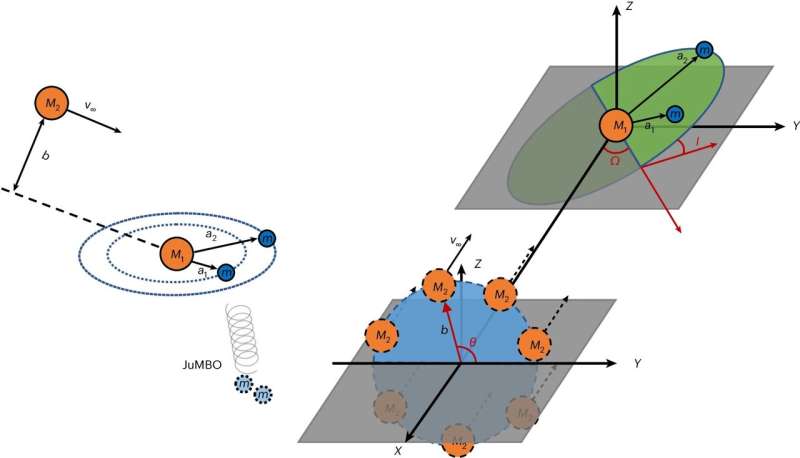Schematic diagram of a JuMBO produced by a stellar encounter. Left: A star’s close flyby of a planetary system caused two planets to be ejected, and the two planets remain bound together, forming a floating planetary binary.Right: Two coplanar planets of equal mass orbiting a star of mass M1.An intruding star with mass M2 Flying by with asymptotic speed v Parallel to the X direction, the impact parameter is b, and the angle is perpendicular to the M movement direction2.The plane of the planet’s orbit forms an angle I and is rotated by an angle relative to the direction of motion of M2. Credit: natural astronomy (2024). DOI: 10.1038/s41550-024-02239-2
The recent discovery of a potentially new class of distant and mysterious “free-floating” planets has piqued the interest of astronomers since stunning new images from the James Webb Space Telescope were shared late last year.
Known as Jupiter-mass binary objects (JuMBOs), these candidate planets float freely in space without being bound to any star and appear to orbit each other—contrary to popular theories of how planetary systems work.
Now, a team of astrophysicists at UNLV and Stony Brook University has published a new study April 19 in the journal natural astronomyintroduce a convincing model to explain how these JuMBOs form.
The team used an advanced technique called direct N-body simulations to explore how interactions within dense star clusters can lead to ejections of giant planets that remain gravitationally bound to each other as they drift through the galaxy. This important study provides a model for how these mysterious binaries form, filling a key gap in our understanding of planetary evolution.
“Our simulations show that close stellar encounters spontaneously eject pairs of giant planets from their native systems,” said Yihan Wang, the study’s corresponding author and a postdoctoral researcher at the Center for Astrophysics at the University of Nevada, Las Vegas. causing them to orbit each other in space. “These findings could significantly change our view of planetary dynamics and the diversity of planetary systems in the universe. “
Research shows that such events are more likely to occur in densely populated star clusters, suggesting that free-floating binary planets may be more common than previously thought. Characteristics of these planet pairs—such as their separation and orbital eccentricity—provide new insights into the dramatic environmental conditions that influence planet formation.
“It introduces dynamic stellar interactions as an important factor in the development of unusual planetary systems in dense stellar environments,” said study co-author Rosalba Perna, a professor of physics and astronomy at Stony Brook University.
The researchers say the new work broadens our understanding of planet formation and lays the foundation for future observations with the James Webb Space Telescope (JWST), which could provide further evidence to support the team’s predictions.
“Understanding the formation of JuMBOs helps us challenge and refine popular theories of planet formation,” said Zhaohuan Zhu, an astrophysicist at the University of Nevada, Las Vegas and study co-author. “JWST’s upcoming observations may help us do just that, with each observation providing new insights that will help us better formulate new theories of giant planet formation.”
More information:
Yihan Wang et al., Free-floating binary planets ejected during close stellar encounters, natural astronomy (2024). DOI: 10.1038/s41550-024-02239-2
Provided by University of Nevada, Las Vegas
citation: Astronomers provide new model for the formation of recently discovered ‘free-floating’ planets (2024, April 22), Retrieved April 22, 2024 https://phys.org/news/2024-04- astronomers-formation-free-planets.html
This document is protected by copyright. No part may be reproduced without written permission except in the interests of fair dealing for private study or research purposes. Content is for reference only.
#Astronomers #provide #model #formation #discovered #freefloating #planets
Image Source : phys.org
